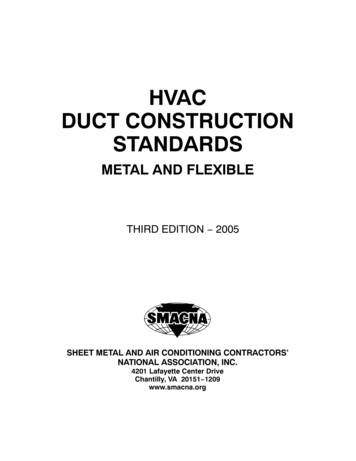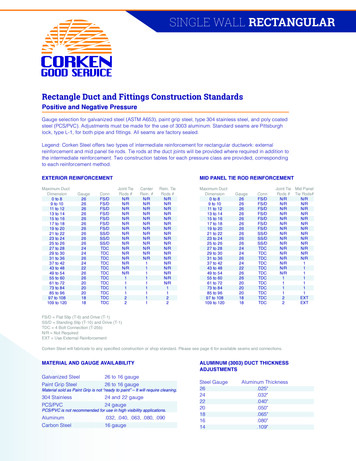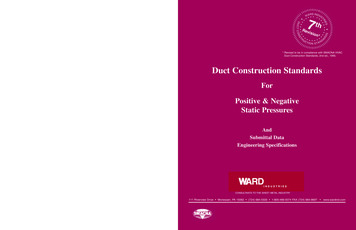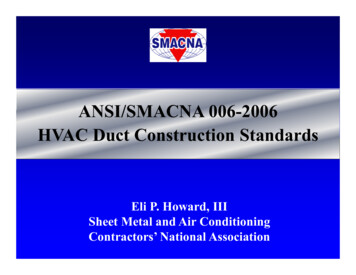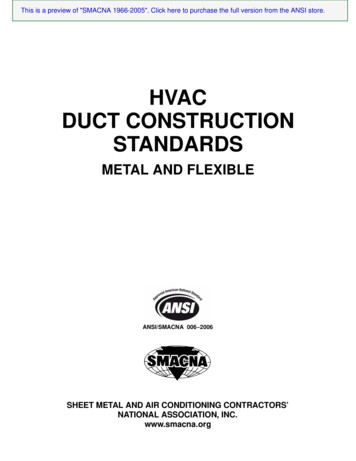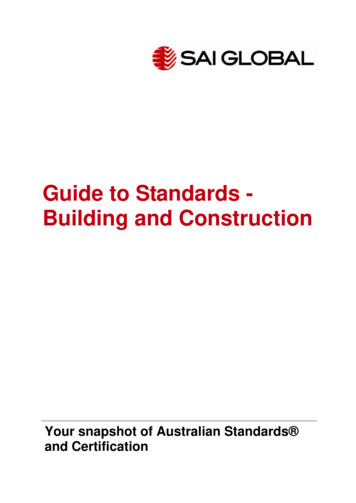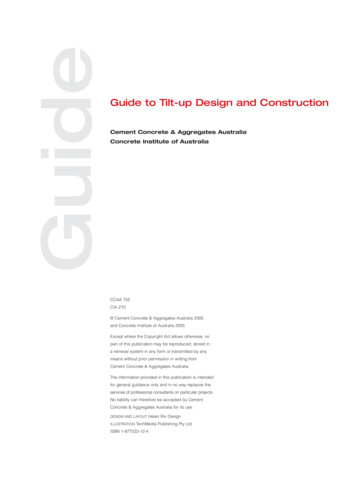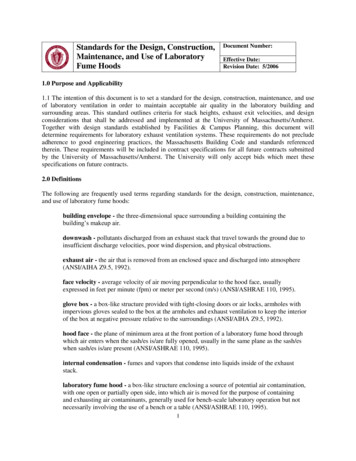
Transcription
Standards for the Design, Construction,Maintenance, and Use of LaboratoryFume HoodsDocument Number:Effective Date:Revision Date: 5/20061.0 Purpose and Applicability1.1 The intention of this document is to set a standard for the design, construction, maintenance, and useof laboratory ventilation in order to maintain acceptable air quality in the laboratory building andsurrounding areas. This standard outlines criteria for stack heights, exhaust exit velocities, and designconsiderations that shall be addressed and implemented at the University of Massachusetts/Amherst.Together with design standards established by Facilities & Campus Planning, this document willdetermine requirements for laboratory exhaust ventilation systems. These requirements do not precludeadherence to good engineering practices, the Massachusetts Building Code and standards referencedtherein. These requirements will be included in contract specifications for all future contracts submittedby the University of Massachusetts/Amherst. The University will only accept bids which meet thesespecifications on future contracts.2.0 DefinitionsThe following are frequently used terms regarding standards for the design, construction, maintenance,and use of laboratory fume hoods:building envelope - the three-dimensional space surrounding a building containing thebuilding’s makeup air.downwash - pollutants discharged from an exhaust stack that travel towards the ground due toinsufficient discharge velocities, poor wind dispersion, and physical obstructions.exhaust air - the air that is removed from an enclosed space and discharged into atmosphere(ANSI/AIHA Z9.5, 1992).face velocity - average velocity of air moving perpendicular to the hood face, usuallyexpressed in feet per minute (fpm) or meter per second (m/s) (ANSI/ASHRAE 110, 1995).glove box - a box-like structure provided with tight-closing doors or air locks, armholes withimpervious gloves sealed to the box at the armholes and exhaust ventilation to keep the interiorof the box at negative pressure relative to the surroundings (ANSI/AIHA Z9.5, 1992).hood face - the plane of minimum area at the front portion of a laboratory fume hood throughwhich air enters when the sash/es is/are fully opened, usually in the same plane as the sash/eswhen sash/es is/are present (ANSI/ASHRAE 110, 1995).internal condensation - fumes and vapors that condense into liquids inside of the exhauststack.laboratory fume hood - a box-like structure enclosing a source of potential air contamination,with one open or partially open side, into which air is moved for the purpose of containingand exhausting air contaminants, generally used for bench-scale laboratory operation but notnecessarily involving the use of a bench or a table (ANSI/ASHRAE 110, 1995).1
lpm - liters per minute (ANSI/ASHRAE 110, 1995).makeup air - outside air drawn into a ventilation system to replace exhaust air (ANSI/AIHAZ9.5, 1992). Makeup air MUST always be provided when any exhaust system is designed andinstalled.perchloric acid hood - a fume hood constructed with water wash so it is safe for use withperchloric acid or other reagents that might form flammable or explosive compounds withorganic materials of construction (ANSI/AIHA Z9.5, 1992).recirculation - air withdrawn from a space, passed through a ventilation system, anddelivered again to an occupied space (ANSI/AIHA Z9.5, 1992).reentry - The flow of contaminated air that has been exhausted from a space back into thespace through air intakes or openings in the walls of the space (ANSI/AIHA Z9.5, 1992).replacement air - see makeup air.return air - air being returned from a space to the ventilation fan that supplies air to a space(ANSI/AIHA Z9.5, 1992).special purpose hood - an exhaust hood, not otherwise classified, for a special purpose such as,but not limited to, capturing gases from equipment such as atomic absorption, gaschromatographs, liquid pouring or mixing stations, and heat sources (ANSI/AIHA Z9.5, 1992).variable air volume fume hood - a fume hood designed so the exhaust volume is varied inproportion to the opening of the hood face by changing the speed of the exhaust blower or byoperating a damper in the exhaust hood (ANSI/AIHA Z9.5, 1992).velocity - speed and direction of motion (ANSI/AIHA Z9.5, 1992).walk-in hood - a fume hood designed to be floor mounted with sash and/or doors for closing theopen face (ANSI/AIHA Z9.5, 1992).3.0 Roles and ResponsibilitiesEnvironmental Health & Safety:Inspects the entire fume hood operating systems including the fume hood, associated ductwork, exhaust blowers, and stacks;Places a sticker on fume hoods with average face velocity if the hood operating systems"PASS";Places a "DO NOT USE" sign on the hood sash if the hood operating system does "NOTPASS";Puts in a work order on behalf of the department head to Physical Plant for repair;Notifies the Department Head, Department Health and Safety Coordinator, Physical Plant,and Facilities Planning of any hoods which are deemed "OUT OF SERVICE."2
Physical Plant and Facilities Planning:In a timely manner, makes all necessary repairs/modifications to the fume hood operatingsystem and any associated equipment which affects the fume hood operating system in orderto make the entire system safe to use;Notifies Environmental Health and Safety (EH&S) after all repairs/modifications arecompleted. EH&S then retests the system;Notifies EH&S on a monthly basis in writing as to the status of repair/replacement of fumehoods based on work orders/work requests submitted.Department Head:Ensures that any fume hoods which are deemed "OUT OF SERVICE" will not be used untilnotified by EH&S that the hood can be used;Ensures that repairs/modifications are completed in a timely manner to any fume hoodswhich have been deemed "OUT OF SERVICE";Notifies EH&S and Physical Plant of any fume hoods which are not operating properly.Personnel Using Fume Hoods:Follow all safety and health procedures specified in the Laboratory Health and Safety Manualand by the faculty supervisor in the laboratory;Attend all required health and safety training sessions;Do not use fume hoods which are "OUT OF SERVICE";Report fume hoods which are not operating properly, accidents, unhealthy and unsafeconditions to the faculty supervisor;Notify faculty supervisor of any pre-existing health conditions that could lead to serioushealth situations when using a fume hood.4.0 Procedure4.1 Laboratory exhaust ventilation systems designed, constructed, maintained, and used at the Universityof Massachusetts/Amherst shall comply with the specifications and standards set forth in this documentand in the publications listed (see 5.0 Key References). Failure to meet these standards shall be referredto the Institutional Chemical Safety Committee (ICSC).4.2 Fume Hood Design and Construction – The Standards for the Design, Construction, Maintenance,and Use of Laboratory Fume Hoods will concentrate on the aspects of fume hood system design andoperation that are critical to protecting the health and safety of faculty, staff, students, and visitors andalso minimizing nuisance odors. Properly designed systems function to capture contaminants from thework area and disperse them in the outside environment. Exhaust stacks function to release contaminantsfrom the inside of a building in order to minimize contaminant re-entrainment.The critical design aspects of fume hood systems that are discussed in this document are: the quality ofthe fume hood enclosure, the quality and quantity of supply air provided to the fume hood, face velocityof the fume hood, exhaust stack height, exit velocity of air being exhausted from the stack. In addition,effluent dispersal is contingent upon factors such as exhaust stack/air intake separation, stack height, stackheight plus momentum, topography of the building and surrounding environment, and wind dynamics.3
Although system performance depends heavily on the above design elements, it must be noted that thefume hood performance in a room is affected by room layout and supply air distribution. Systemperformance depends on the fan and duct layout as well as fan type and discharge conditions. Theseissues are dealt with in detail in the mechanical design standards developed by Facilities & CampusPlanning (FCP).4.2.1 Laboratory Chemical Hoods: Minimum SpecificationThe design and construction of laboratory chemical hoods shall conform to the applicable guidelinespresented in the latest edition of ACGIH’s “Industrial Ventilation: A Manual of Recommended Practice,”and all other applicable local codes, guidelines and regulations.The following are recommended design features for fume hoods:Work surfaces should be recessed at least 3/8 inches below the front edge of the bench orsurface. Side and back of the fume hood should have a seamless lip at least 3/8 incheshigh in order to contain spill.Provide airfoils or other sidewall designs to reduce leakage and airflow eddy at the frontedge of the bench and on the front side posts external to the sash.Utilities should be located outside the hood. Other non-electrical utilities, if required, canbe located inside the fume hood provided they have outside cut offs and should notsubject the operators to exposure from materials inside the hood.Laboratory fume hoods and associated exhaust ducts should be constructed of noncombustible, nonporous material that will resist corrosion. They should be equipped withvertical or horizontal sashes that can be closed, air foils that are built into the fume hoodat the bottom and the sides of the sash opening, and baffles to attain a uniform facevelocity under different conditions of hood use.Baffles should be designed to capture material generated within the hood and distributethe flow throughout the opening to minimize potential escape.Combination horizontal and vertical sashes shall be provided unless special conditionsdictate otherwise. Types of sashes available are:1. Vertical raised sash2. Horizontal sliding sash3. Combination vertical raising and horizontal sliding sashAdditionally, recognized good design and construction features are listed in ANSI/AIHA Z9.5 2003.Sashes shall not be removed when the hood is in use. Sash limiting devices, if installed, shall not beremoved if the design opening is less than a full opening. Vertical raised sashes shall be limited to an 18inch opening or at half sash. Combination sashes should have the same limiting device at 18 inches (orhalf vertical sash opening).4.2.2 Laboratory Chemical Fume Hoods - Hoods TypesBypass hood - Bypass fume hoods should be designed so the the bypass opens progressively andproportionately as the sash travels to the fully closed position. The hood exhaust volume shall remainessentially unchanged (.5% change) when the sash is fully closed (ANSI AIHA Z9.5-2003).Conventional fume hoods (CAV) - These hoods shall meet the requirement in Section 4.3. Theexhaust volume shall remain unchanged with the sash in full open position or in the design open position4
(half sash). As the sash is lowered the face velocity will increase. Velocity should be at maximum whenthe sash is opened at about 18 inches or at half sash.Auxiliary supplied air fume hoods - These hoods also have to meet the requirement in 4.3.Auxiliary supplied air hoods are not recommended unless special energy conditions or designcircumstance exits. The following requirements must be met in an auxiliary hood design:1. The supply plenum shall be located externally and above the hood face;2. The auxiliary air shall be released outside the hood;3. The supply jet shall be distributed so as not to affect hood containment and orincrease potential for air escape from the hood.Perchloric acid laboratory chemical hoods - Perchloric acid hoods are laboratory hoods whichmeet the requirement of Section 4.3 and NFPA 45. In addition, the following requirement must be met forperchloric acid hoods:All inside surfaces shall use materials that will be stable and not react with perchloric acidto form corrosive, flammable and/or explosive compounds or by-products.All interior hood duct fan and stack surfaces shall be equipped with water wash downcapacities.All ductwork shall have smooth welded seams and also be made of material that wouldnot react with perchloric acids and or its by-products.No part of the system should be manifolded to a nonperchloric acid exhaust system.No organic material including gaskets, which can react with the perchloric acid and itsbyproduct, should be used for the construction of perchloric acids fume hoods.Perchloric acid hoods should be labeled clearly as: “Perchloric acid Hood”(source: ANSI/AIHA Z 9.5-2003).Floor mounted hoods (also called walking fume hoods) - Floor mounted fume hoods can be usedwhen the vertical working space of a bench hood is inadequate for the work or apparatus to be used in thehood. The base of the hoods should be contiguous with the sidewalls and a vertical lip at least 1 inch orequivalent to provide for spill containment. Door and panel should be constructed to allow it to be openedfor the installation of apparatus.4.2.3 Variable air volume(VAV) hoodsGeneral Purpose VAV Fume Hoods shall be capable of varying the exhaust air volume inproportion to the hood face opening by either changing the speed of the exhaust blower or by adjusting adamper in the exhaust duct for general laboratory fume hood operations.Special Purpose VAV Fume Hoods shall be capable of varying the exhaust air volume inproportion to the hood face opening by either changing the speed of the exhaust blower or by adjusting adamper in the exhaust duct for fume hoods containing approved equipment or apparatus on a permanentbasis. Note: VAV fume hoods are not permitted for radiation and perchloric acid activities.General VAV Fume Hood Control System Requirements:1. Airflow sensors and quick response (three seconds or less) pressure independent valves shall beinstalled in each exhaust du
(ANSI/AIHA Z9.5, 1992). special purpose hood - an exhaust hood, not otherwise classified, for a special purpose such as, but not limited to, capturing gases from equipment such as atomic absorption, gas chromatographs, liquid pouring or mixing stations, and heat sources (ANSI/AIHA Z9.5, 1992).File Size: 298KBPage Count: 26


